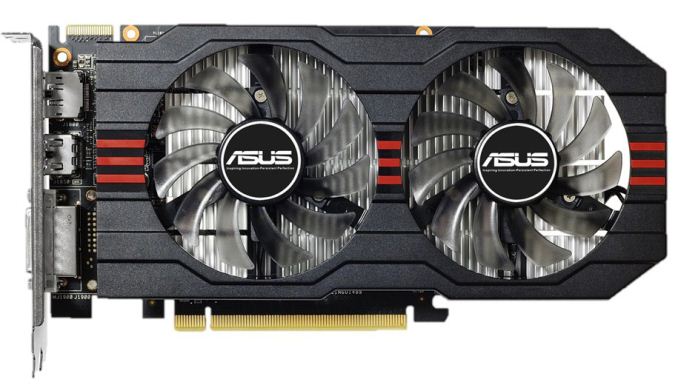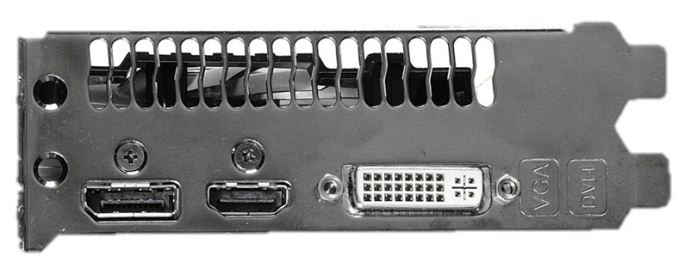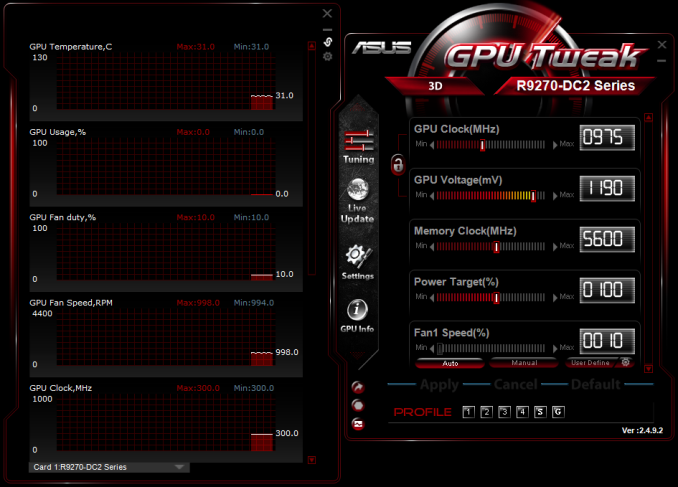The AMD Radeon R7 265 & R7 260 Review: Feat Sapphire & Asus
by Ryan Smith on February 13, 2014 8:00 AM ESTMeet The Asus Radeon R7 260
Our other card of the day is our R7 260 sample from AMD, which comes in the form of a complete retail card: Asus’s Radeon R7 260. This is a standard retail card, featuring a solid design but no factory overclock or other frills.
Surprisingly for a 95W card, Asus’s card is a dual fan open air design. Based on a variation of their dual fan coolers, Asus utilizes a relatively simple aluminum heatsink directly mounted to the Bonaire GPU beneath. This heatsink has a large base that serves to cover the RAM, but not the VRMs towards the front of the card, and mushrooms out at the top to form a larger surface for the dual fans to cool. Truth be told we were pleasantly surprised by this design; these larger dual fan designs are uncommon for sub-100W cards, and even with the relatively simple heatsink it’s essentially oversized for the GPU in question, though as we’ll see in our noise results this is clearly to the benefit of the user.
As a result of using such a large cooler on such a small board, the Asus R7 260’s cooler significantly overhangs the PCB. The PCB itself is just 6.8” long, while the cooler extends a further 1.9” to give the card a total length of 8.7”. As is usual for Asus, the card feature’s Asus’s Super Alloy Power discrete electrical components for enhanced durability. Meanwhile the fact that this is closer to a card strapped to a cooler than a cooler strapped to a card doesn’t do Asus any favors, especially since the GPU is towards the rear of the card. The short length of the card ensures it’s rigid enough, but there’s some opportunity for flexing towards the front of the card.
For Asus’s power connectivity, the single 6-pin PCIe power socket is found at the end of the card, orientated parallel to the PCB despite the significant overhang of the cooler. To make up for this, Asus has once again reversed the PCIe power socket so that the tab on the plug faces inwards instead of outwards, which makes this design practical as the cooler no longer blocks the tab.
As for Asus’s display I/O, Asus is using a simpler port layout that occupies just a single slot, presumably so that this PCB is capable of being used on single-slot designs if necessary. This results in the card having 1x DL-DVI, 1x HDMI, and happily enough for such a low-end card, 1x DisplayPort, as opposed to a VGA port. This gives the Asus card the ability to drive three digital displays at once for Eyefinity, or even a single 4K display if we’re talking about simple desktop work.
Meanwhile on the software side of things the R7 260 comes with Asus’s standard GPUTweak software utility. GPUTweak is a very competent overclocking suite that offers all of the overclocking and monitoring functionality we’ve come to expect from a good overclocking utility, including a wide array of monitoring options and support for GPU voltage control. Asus’s taste in skins is unfortunate – a low contrast red on black – but otherwise the UI itself is similarly solid. To that end GPU Tweak won’t match Afterburner on some of its more fringe features such as recording and overlays, but as a pure overclocking utility it stands up rather nicely.
Wrapping things up, as one of the only two R7 260 graphics cards currently Asus is both enjoying and being disrupted by the lack of sensible pricing among R7 260 cards. At a current retail price of $139 the Asus R7 260 is a full $30 (28%) over what should be a $109 MSRP for an R7 260 card, and $15 more expensive than the alternative MSI card. More importantly, it’s currently just as expensive as the more powerful R7 260X, which puts this card in an unfortunate spot since you can easily buy a more powerful card for less. Asus can enjoy a small premium from a good design and their 3 year warranty, but this is an especially treacherous position if R7 260X prices quickly come down to $119.
Finally, on a quick technical note we do want to point out that we have encountered one minor oddity with the Asus R7 260 that as of this writing is still being looked into by AMD. The card we received has its GPU idle clockspeed at 550MHz, instead of the 300MHz clockspeed that is common for all other AMD GCN cards, including their other Bonaire cards. The ramifications of this are minimal as it doesn’t affect the load performance of the card in any way, but it does mean the card is technically running at a higher clockspeed than it should at idle, which can affect idle power consumption. We’re seeing 74W at the wall, the same as our reference R7 260X, but our GPU testbed is admittedly not well suited to picking up small fluctuations in idle power consumption like this on such a low powered card. In any case we don’t believe it to be a dealbreaker, but AMD is currently looking into it to try to determine what’s going on.














52 Comments
View All Comments
just4U - Thursday, February 13, 2014 - link
While you may be right... AMD/Ati does like throwing popular configurations into the mix.. The 265 reminds me a lot of the 4830 and while that card was fairly short lived it was a hot seller for them as it straddled two performance areas but came in at a nicer price point.jabber - Friday, February 14, 2014 - link
Indeed I swapped from being a longtime Nvidia user to AMD back in 2009 as I got fed up with Nvidia regurgitating the old 8800 chips three times in a row for the mid level.Stuff doesn't have to change radically performance wise but its nice to know new features are added and other things get revised and tweaked. A simple name change isn't enough really.
MrSpadge - Thursday, February 13, 2014 - link
I'm actually happy they're finally making use of that last digit in their 3-number scheme. From my point of view they could have ditched the X altogether and make the R9-270X an R9-275 (or whatever is appropriate). And speaking of R9: they could have given the R7 265 the rating R9 265 to more closely connect it with R9 270. Or just drop that prefix as well, if the numbers don't overlap anyway and the R9/7/3 is not related to features either!Speaking about the cards:
- boost clocks additional 25 MHz again? I have no idea why these are there. Make it 100+ MHz of leave it.
- 1.175 V for a mere 925 MHz? The chip should be able to do 1.0 GHz at ~1.0 V, maybe 1.10 V for guaranteed clocks
- same for R7 260 - that voltage is ridiculously high
Anyway, the cards themselves are fine (just like the 7000 series) and the coolers really fit them.
silverblue - Thursday, February 13, 2014 - link
The single GPU frame latency issue has been fixed for more than six months. I doubt it's going to become a problem again like with AMD's handling of 2D a while back.There are remarks concerning the availability of the R9 270 series and the inability for these parts to keep to their RRP, both of which may not be present if this was some sort of fanboy review.
Spuke - Thursday, February 13, 2014 - link
Has it been 6 months? I thought they recently fixed that problem.silverblue - Thursday, February 13, 2014 - link
It was fixed in Cat 13.8 Beta 1, dated 1st August.silverblue - Thursday, February 13, 2014 - link
My bad - that's when CrossFire had its first fix. Apparently, single-GPU was fixed beforehand, though I can't find which driver version it was.Solid State Brain - Thursday, February 13, 2014 - link
Anandtech: it would be interesting if you tested idle power consumption in multi monitor scenarios. I think you will find out some surprises.creed3020 - Thursday, February 13, 2014 - link
Excellent point!I had a friend with a 6950 and he was furious that his video card would never idle down in gpu/memory frequencies when he had a second monitor connected.
I personally have a 6850 and two 20" LCDs connected over DVI. I have not looked for the same behaviour but would not be surprised if it were the same.
Power efficiencies are out the window once the user chooses to go multi-monitor to be more productive.e
Solid State Brain - Thursday, February 13, 2014 - link
I have the same issue with my HD7770 to a lesser extent and my workaround for that is connecting my two secondary displays on the integrated Intel GPU. This saves a significant amount of power.